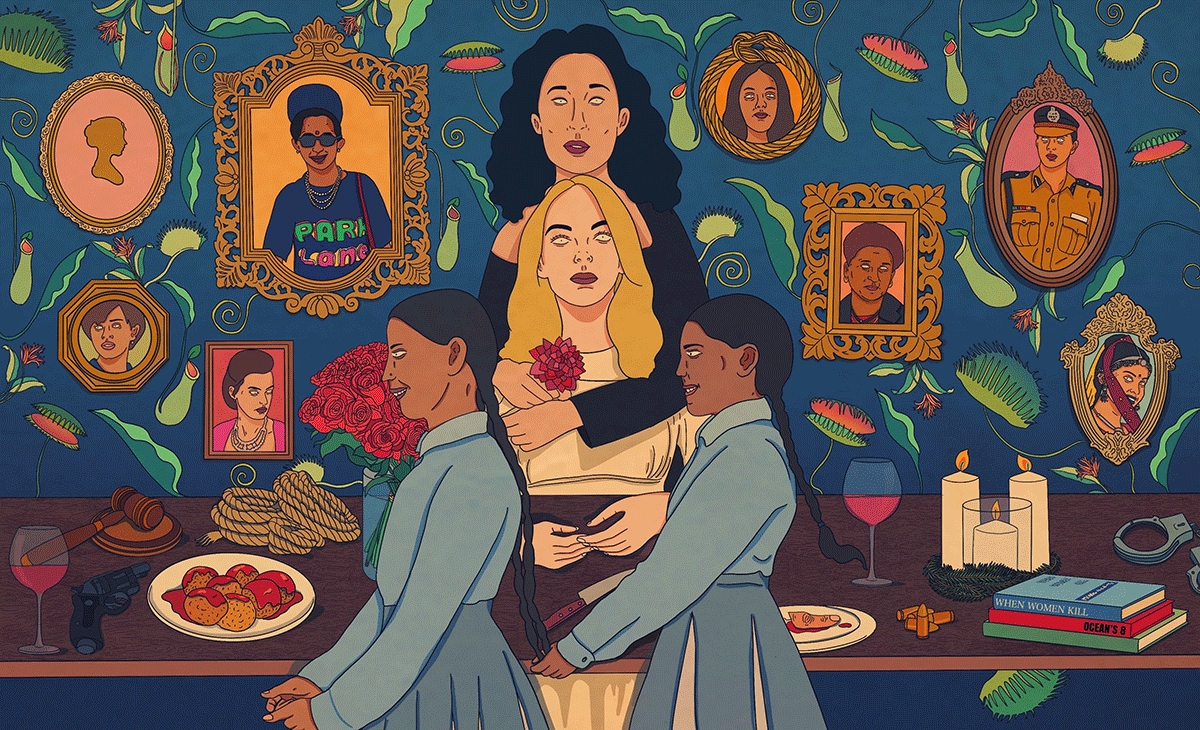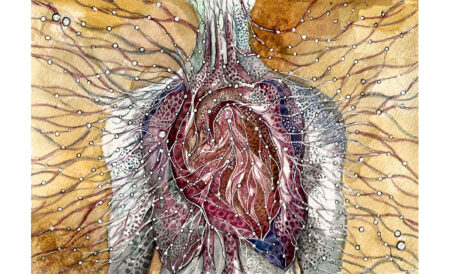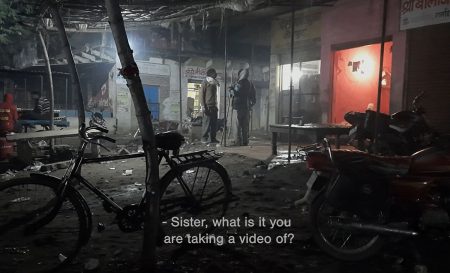Among the many gifts that the classroom throws in my face, one that I am equally envious and enamored by is the beehive of female friendships all around me.
It’s in the way a student will lie to my face to cover for her friend who is late to class again because, “please ma’am, she is literally outside the door and will walk in any moment now”; in the rude gesture she makes to her friend, aggressively signaling to “come fast ya! ma’am is taking attendance!” seconds after she was barely awake to give her own attendance; in the strong grasp over each other’s secrets – saved in tight fists; in the quiet length and breadth of hugs they give, and in how generously they wait for one another.
The boys I went to college with seemed to view female friendships with bitterness and were confident that it’s mostly dikhawa and that “one boy is enough to break their friendship” frame of mind. At home, I was taught to trust the idea of marriage with men (only marriage, no love and all) more than friendship with women. So when I see young women doing something it took me years plus feminism to do, I can’t help but admire them.
One day I asked my students, Eleena and Hasya, if they would help cover up crime if one of them were to murder somebody. Both said yes and both didn’t hesitate. I probed some more and Eleena said, “Ma’am, I’m sure her reasons to kill would be silly but I also know that I’m the only person in the world to understand her silliness.”
I first noticed Eleena and Hasya while returning from class one day. They were clinging to each other in the corridor, trying to get each other to stop laughing. They’d been told off earlier that day about making too much noise in the corridor so now, Hasya’s hands were trying to cover Eleena’s guffawing mouth and Eleena’s were trying to cover Hasya’s. They kept missing and trying.
Eleena and Hasya aren’t like other teenagers I usually find in the classroom. They both have a shared disinterest in phones, technology, and things they both imply.
This may not be out of choice since they also share a lack of money which is central to how much we are able to enjoy phones and technology. But what I found intriguing about them was that they weren’t what I am quick to register as ‘woke’.
Eleena tells me that their first night on a phone call with each other (which lasted well into the next morning), Hasya asked Eleena what she was. To clarify, she added, “are you ‘choir’ or bi or something because I can tell you are something but don’t know what.”
Eleena was kinder than me because I couldn’t stop laughing for hours. In that simple way in which we sometimes get people, Eleena had understood and was already used to Hasya’s language and said, still giggling, “Ok, Hasya. If you want me to be ‘choir’, I am choir”.
It wasn’t the pronunciation that made it funny. (Mine isn’t great – until a student corrected me – I believed bicycles were pronounced bi-cycles). But I was charmed by how quickly they seemed to learn each other’s language with a kind of openness that is rare and more earnest than the quick surrender we make to new-agey terms. By calling it ‘choir’, she was perhaps saying I know of it even if I don’t know it very well but I’m curious to know if you are it. And by already getting what Hasya meant, Eleena was saying “I understood it even if you weren’t being clear”. There was a vague innocence in the conversation and its retelling, which I had already begun responding to.
Eleena and Hasya are very different from my other favorite female friendship jodi – Luda and Milena, who I met in a terrific short story by writer Lara Vapnyar. Luda and Milena, two women of Russian origin, live in America, and are trying to learn English. They begin competing with each other for a man named Aron. He likes eating so both women spend weeks hating each other, and cooking for Aron aggressively. They (we) wait for his verdict until one morning, Aron chokes on a Russian meatball and dies. Needless to say, it might’ve been a meatball cooked either by Luda or Milena. We don’t know. But what we do know is that they become friends after Aron dies and that they finally admit to each other something we have suspected all along – Luda and Milena detest cooking.
Did Aron have to die for Luda and Milena to see each other is a good question but I’m afraid it’s a joyless question. So what if he dies?
What was funny to me was that he died choking on some meatball while Luda and Milena, the culprits, were probably looking elsewhere already. It’s funny, it’s criminal, it’s mad.
Aron’s death is perhaps an accident but I don’t want to entirely erase the poetic feminist justice theater that is visible in this narrative which has deviously but cutely murdered Aron for the simple crime of enjoying food just so Luda and Milena could become friends. Again, a possibility – not a promise. I’m sure there are many Ludas and Milenas out there whose friendship began perfectly well i.e., without having a paapa man accidentally murdered but where is the fun in that?
****
Among the many stunning scenes from season one of Killing Eve, what killed me was when MI6 Analyst, Eve Polastri describes seeing notorious female assassin, Villanelle, to a police sketch-artist. Eve doesn’t even try to withhold what is only the most romantic way to remember someone you’ve seen for less than 30 seconds, an assassin no less.
“Her hair is dark blonde, maybe honey. It was tied back. She was slim, about 25-26. She had very delicate features, her eyes are sort of cat-like – wide but alert. Her lips are full, she has a long neck, high cheekbones. Her skin is smooth and bright. She had a lost look in her eye that was both direct and also chilling. She is totally focused yet almost entirely inaccessible.”
After this deeply observant, potently descriptive, full bodied, warm, and swollen memory of a woman Eve didn’t know then was an assassin, the only thing the police sketch-artist asks is, “Uhhh, so is that like a square face or an oval face?”
It seems fair that it’s the only logical question he may have, going by how much like a lover Eve is already beginning to see Villanelle but something about the way women remember women and how this is starkly different from how men remember women is being made visible here. Much like Eve, it wasn’t until I met Villanelle that I began to think hard and strong about Laurel Thatcher Ulrich’s celebrated lines “Well-behaved women seldom make history”.
“I am just a fan,” Eve says about Villanelle’s sharpness with her art, i.e. how swiftly she murders, leaving no pattern behind, “She doesn’t have a signature but she has style.”
I think of Villanelle often. Especially when I am at work meetings with higher-ups in AC rooms and fancy lighting. Every other man in this room is well, a man. But the few women there are, are always well-behaved women who nod and get along well with men and never disagree with them. I think of Villanelle because I think of what she’d do here and how she’d change this setting for me.
But mostly I think of her because I am bored and Villanelle’s battle against the world is coming from a refusal to be bored.
Writer Paromita Vohra’s profound approach to feminism is that it’s also a refusal to be bored by men.
Villanelle is a textbook criminal. She’s fictional but made of very real stuff. Her listless yet focused way of killing comes from a fear of life going on in this uninterrupted manner, without a challenge. Her eyes are vacant and watchful but when she first sees Eve, she sees Eve – as a challenge, a flick of desire, a beautiful release, not an escape, which made me wonder if she was doing what she did only to find friendship with women.
In the first episode, we see a book intriguingly named, When Women Kill on Eve’s table. Its first page is a dive into why poison is the most used weapon by female criminals.
Alleged poisoning was the crime of nineteenth-century America, and “murder by poison was particularly feared because there was no way to see it coming or to defend against it”; poisoning was also “associated with women” (Jones, 1980: 103). In fact, throughout history, women who kill have been viewed as distancing themselves from their victims through the application of measured doses of poison over lengthy periods of time – a murder method often considered devious, cunning, and deceitful.
Curry & Cyanide, a true-crime docuseries released last December on Netflix, makes a loose attempt at documenting the famed Koodathai Cyanide Killing Case and its perpetrator, Jolly Joseph. In the beginning, we are shown pictures as proof of Jolly’s shaukeen ambitions – photographs of young Jolly Joseph dressed “flamboyantly” in a park lane t-shirt and jeans, cap and sunglasses, earrings, bindi, and a three-strand pearl necklace – side by side with one more photograph where she is dressed similarly but now posing on a Luna.
I am curious to know the woman in these pictures. Not to know if it was the same woman who later used cyanide to kill her in-laws but to know her like Eve wanted to know Villanelle because she looked outlandishly cool. In 1986, criminologist Meda Chesney-Lind authored a paper titled, ‘Women and Crime: The Female Offender’ where she remarks, “Essentially, too little is known and too much assumed about the nature of women’s crime.” In the same paper, Meda addresses the hysteria surrounding women’s crime that isn’t able to go beyond the question: “How could she?”
Whether it is 1986 or 2023, not much has changed in the way we tend to participate in asking the question “how could she?” about female criminals. Journalist Nikhila Henry’s expansive reporting on the Koodathai case reveals that regardless of how well people knew Jolly Joseph, no one seemed to hesitate asking “how could she?”
In October 2019, Nikhila Henry wrote extensively about the divided opinions held among neighbors about Jolly Joseph. “The women were kinder with their words. Fathima Beevi seemed in awe of Jolly as she called her the “woman who was brave enough to kill six”. Jameela, in her 40s, referred to Jolly as “Nallol”, a good woman. Suhara, who lives in the neighborhood, said, “She [Jolly] was always kind and welcoming. Very social. You would find her at all sorts of public gatherings and marriages, interacting gracefully with people.”
In the Netflix documentary, there is news footage featuring Jolly Joseph being escorted into a police jeep. Henry recalls being there when a throng of men stood around, catcalling Jolly Joseph, shouting “high range, high range” and other such sexually-laden remarks. Around the same time, there were also rumors about her involvement in a sex racket.
There is a perverse desire to link any crime committed by women to a loose, ‘immoral’ freedom with sex. Taking that further, the loopholes in the investigation revealed that all the years Jolly Joseph spent pretending to be a teacher at NIT were years ‘unaccounted for’ – and it is here, in these missing years, that people tend to have a field day of their own suspicions around Joseph’s sexual promiscuity, something male criminals aren’t subject to.
The fear of women having a good time, of having ‘non-boring’ sex runs deep in the minds of people. It’s what we think is actually a punishable crime. Somehow the idea that when she was lying about this NIT job, she must have been having sex, and that that is worse than all the cyanide murders is also something she is being punished for.
Bringing us to wonder why is it that when the desire to punish women (for behaving like men) isn’t sought from an idea of justice but from some superior moral compass, why do we still trust the court to remain blind to such a moral compass? Are they able to? Are we afraid that relying on justice might mean a closer look into the structures, the monologues, and the interiority of women who commit crime? Are we afraid that we don’t know what to do about that? Are we afraid that the only real possible justice at the moment is to redo/undo history?
Thanks to Nikhila Henry’s interruption of this narrow outlook of the case, new perspectives seem to have come to light, chief among them is a growing concern about women and land rights.
That at the heart of this case, like many other cases, is also the undisturbed history of keeping women out of any access to land or land rights.
Does this then not mean that we need a more studied and feminist approach to understanding women’s crimes? As also land, money, capital, and access to a just means of attaining these especially if women’s crimes are invisibly or visibly linked to their access to a stable economy and how much they might have to rely on other people, usually men to provide this for them?
It is strange that in a world that isn’t able to go beyond the pull of “how could she?” – motive isn’t as studied as it should be, at least in the case of female criminals. I’m only saying this as a way of addressing my real curiosity, which is, since Villanelle’s choice of weapon is rarely as discreet as poison, what would it be like to have Jolly Joseph and Villanelle talk to each other?
Here is a glorious hint – In those NIT years, as Nikhila Henry found out, Jolly Joseph was just hanging out in beauty parlours.
****
Since it’s not possible for Villanelle and Jolly Joseph to ever meet, let us imagine them both in fiction. And now that we have already become so shameless, let us go one step further and also imagine what it would be like to have a feminist court.
The feminist court is a place for mischief, magic, and masti. Let me explain.
Ninety-five-year-old Cynthia Ozick wrote a fun short story in 2008 called Dictation. Set in 1901, the story has at its center, Lillian and Theodora who are typists to writers Joseph Conrad and Henry James respectively. Much like Luda & Milena, Lillian and Theodora are up to something from the beginning. At some point, the two women exchange fragments from each of their boss’ manuscripts and oblivious to both authors, a part of Conrad is now in James’ story and a part of James in Conrad’s story.
Why do they do this? Just.
I am fascinated by this story and its seductive capacity for feminist mischief. It is mischief of the most delicious kind. The story is far more ambitious in its play than any political promise, and just as significant as any protest. Ozick also has an answer to those of us still clinging to cynical relief, to logic, and to righteousness: “Never mind, says Fiction; what fun, laughs Transgression; so what? mocks Dream.”
“There is more to be had, only if we dare to take it.” Theodora says to Lillian when asked what the point of such a mischief is. Conrad and James will remain forever oblivious to this mischief which is designed to remain undetected. It’s only for Lillian, Theodora, and us to know.
Sometimes the feminist court tells us whether really something was crime, defense or revenge. Sometimes I wonder what it’d be like to have a feminist court for the Villanelles we’ve met in fiction/film. What would it do?
In the landmark UK case of Reg. v Ahluwalia [1992], until the timely intervention of a nonprofit called Southall Black Sisters, appellant Kiranjit Ahluwalia was sentenced to life imprisonment for setting fire to her husband’s legs, inadvertently killing him instead. It was only after they foregrounded her ‘crime’ in view of years of domestic violence perpetrated by her husband that the court was pushed to reconsider. She was then able to successfully plead guilty for manslaughter instead of murder on the grounds of diminished responsibility.
This was as early as 1992.
In 2023, we are yet to realize the freedom that can come from changing our lens on crime, wondering what it would be like to look at women’s crimes from a different perspective. In Killing Eve, Eve is no longer thinking that the assassin could be a woman, she is hoping, dreaming, longing for the assassin to be a woman.
After years of working to solve crime, she’s probably seen enough and has figured out that the world needs an assassin to be a woman once in a while. Just to see what it does - for laughs, for thrills, for fun, for power.
****
Sometime in the early 2000s, my mother was watching Snegithiye and despite catching only fleeting bits of the film, and the little Tamizh I was able to gather, I remember feeling thrilled to watch a film that had two college-going girls who sang, danced, rode bikes, got acquitted in a crime, and escaped from the cops without any boyfriends.
I might’ve been young enough to not feel curious about why the cops were chasing those girls but definitely old enough to know that because Tabu was the ACP, this was no ordinary film.
Jyothika and Sharbani Mukherjee play Vasu and Radhika, best friends who worry that their friendship is only real until one of them gets married. It’s only now that I realize my respect for the film because it was able to get right this deeply acute, very real fear. So they come up with a plan to get married at the same time hoping that it would cushion the fall in some way and by being both married at the same time, they would be able to have more in common, buying them extra time to continue their friendship.
This plan is eventually what leads them into trouble later in the film. But as characters from a generation untouched by feminist discourse or its more serious counterpart, twitter – Vasu and Radhika’s desire to keep the intimacy alive and uninterrupted was intriguing. It was more intriguing than the fact that there were barely any men in the police station, the college, or their homes in the film.
The film seemed to prove that the girls might not have had the wherewithal or the political ambition to be anti-marriage but were crazy enough about each other to avoid marriage by getting involved in a crime, and then by running away from it.
They get falsely accused in a murder case but in unconsciously crafting the dream to keep their friendship alive, they were able to will their dream into becoming real.
But the most pressing question seemed to be this – after you battle a false murder charge, what the devil is marriage? The most memorable moment in the film is when Vasu and Radhika’s sworn nemesis, Geetha admits to being jealous of their friendship. She only says this – “You guys are always together.”
Eighteen years later, I was watching Ocean’s Eight with my sister, a woman I spent 20 years of both her life and mine, trying to make miserable. Mercifully, by the time Ocean’s Eight had released, we’d buried the hatchet somewhat happily so it must have been what caused us to hoot and shriek loudly when Anne Hathaway says towards the end of the film that she decided to jump in on the crime because she didn’t have very many close female friendships.
My sister and I lead severely separate lives but we got Anne Hathaway. In the world you and I and my sister live in, crime brings female friends together like even our good friend, protesting patriarchy cannot. The best examples of female friendship occur in close proximity to stories of crime. Almost as if the regular, ordinariness of everyday life isn’t conducive to female friendships.
So, crime is often the conduit through which female friendships are loudly conducted.
****
Luda and Milena made my dry world exciting. It gave me permission to kill the man in my story. Sometimes this man is an annoying woman but ever since I’ve come to know Luda and Milena, somewhere in the jungle of my head, there is a Russian meatball – always within reach.
Through this complicated lineage of women - both from fiction and real - old and young - new and very new; I am wondering what female friendships can do to resist the all too real reality of the world.
In the classroom, I see women very much like Vasu and Radhika.
Earlier this year, I spent days reading and rereading Nisha Susan’s fantastic essay ‘Who will marry me now?’. Written two years after the Dec 2012 Delhi gang rape, the essay features interviews with college going women and documents their experiences in Bangalore and what had changed for them in particular, after news of the Dec 2012 Delhi gang rape.
Akshata tells Susan that she felt suicidal in the first few months of college before she met her friend Nandini because, “I had a cultural shock. In the first couple of months I just felt like crying. Everybody was talking about how they were going to be married as if that was the only way life was supposed to be.”
When she found Nandini, she felt better. Here was a girl who gave her hope, who was telling her what she’d been waiting to hear and what she’d known all along – marriage isn’t the only thing waiting for you outside the college gates.
What Susan’s essay also reveals is young women’s “complete lack of belief in their parents or any form of authority to look after their interests. Though notionally they believe in the law and justice, in practice they don’t believe that anyone in authority will ever help them. Vinisha says with complete conviction that if ever she got raped or got into any sort of trouble, she would never go to her parents – they’d only blame her.”
When Susan asked them who they would turn to if they were in trouble – they all said, ‘our friends’.
Friendships can do that. Young women seek each other out not just for support and friendship but also a form of justice.
In a world that for too long now has thrived on ‘keeping people where they belong,’ listening to young women stick up for each other is comforting, radical, and much needed.
****
Something freeing about the companionship between Frances and Lilian, lovers in Sarah Waters’ 2014 novel, The Paying Guests, is watching Frances see Lilian through a very painful, self-induced abortion. There’s blood everywhere, a ‘crime’ they must clean up before Lilian’s husband comes home. The intimacy these women share as they go about cleaning up blood is nothing like I’ve ever read before. If having sex after everyone goes to bed hasn’t already brought them together, this ‘cleaning up’ of what is known as ‘crime’ outside their immediate world, really does seal the deal.
****
I think again about Eleena and Hasya and how they’ve ‘got’ each other, even if it is only silliness. It’s what I sometimes wish more women could have—friends to help them cover up silliness, crime, revenge, justice. For now, I’m just glad that in knowing their friendship and in knowing friendship through them, the boy-voices from my college days are slowly fading, and all I can hear are guffaws in the corridor.
****





